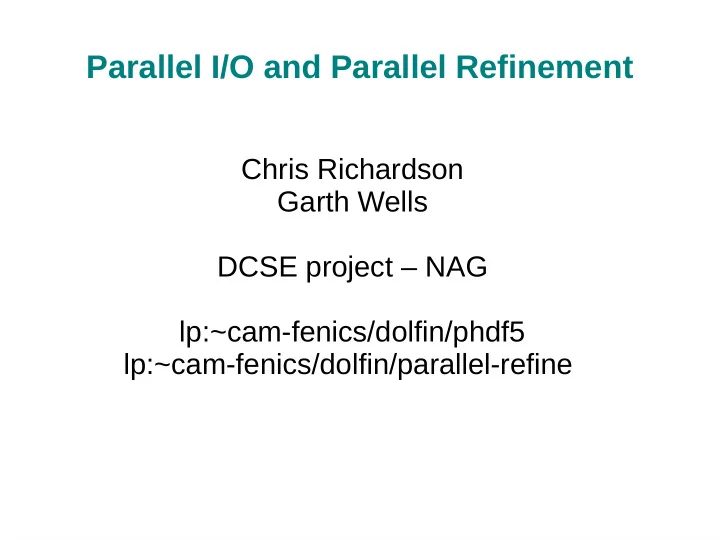

Parallel I/O and Parallel Refinement Chris Richardson Garth Wells DCSE project – NAG lp:~cam-fenics/dolfin/phdf5 lp:~cam-fenics/dolfin/parallel-refine
File access in parallel Motivation: using HPC systems needs I/O that is scalable. ● XMLSAXParser reader is very slow – every process reads whole file and parses part needed ● VTK output – every process outputs a separate file, for each timestep. This can make a lot of files.
Nodes allocated: ================ sand-10-19 sand-10-18 sand-10-11 sand-10-10 49Mcell mesh numprocs=64, numnodes=4, ppn=16 Executing command: ================== mpirun -tune -ppn 16 -np 64 python /home/cnr12/python/bigmesh.py Process 0: Process 0: Summary of timings | Average time Total time Reps ----------------------------------------------------------------------------------------------- Build mesh number mesh entities | 3.0994e-06 3.0994e-06 1 Compute local dual graph | 2.3142 4.6284 2 Compute non-local dual graph | 3.8669 7.7337 2 HDF5: read mesh | 0.16474 0.32948 2 HDF5: reorder vertex values | 0.08997 0.26991 3 HDF5: write mesh to file | 6.0029 18.009 3 Init MPI | 1.576 1.576 1 PARALLEL 1a: Build distributed dual graph (calling ParMETIS) | 2.5287 2.5287 1 PARALLEL 1b: Compute graph partition (calling ParMETIS) | 1.951 1.951 1 PARALLEL 2: Distribute mesh (cells and vertices) | 1.74 5.2201 3 PARALLEL 3: Build mesh (from local mesh data) | 10.994 32.983 3 Partition graph (calling SCOTCH) | 30.229 60.457 2 XML: readSAX | 92.945 92.945 1 compute connectivity 0 - 3 | 0.16687 0.50061 3 compute connectivity 2 - 3 | 0.21143 0.63429 3 compute connectivity 3 - 3 | 2.251 6.753 3 compute entities dim = 2 | 7.0417 21.125 3
HDF5 and XDMF ● HDF5 is a binary data format ● XDMF is an XML metadata format ● Internally, H5 files look like a filesystem ● H5 files allow parallel access using MPI-IO ● Visualisation software (paraview, visit etc.) can read XDMF/H5 in combination ● Can also store multiple datasets / time series
Example XDMF/HDF5 <?xml version="1.0"?> <Xdmf Version="2.0" xmlns:xi="http://www.w3.org/2001/XInclude"> <Domain> <Grid Name="f_0" GridType="Uniform"> <Topology NumberOfElements="800" TopologyType="Triangle"> <DataItem Format="HDF" Dimensions="800 3">new.h5:/Mesh/0/topology</DataItem> </Topology> <Geometry GeometryType="XY"> <DataItem Format="HDF" Dimensions="527 2">new.h5:/Mesh/0/coordinates</DataItem> </Geometry> <Attribute Name="f" AttributeType="Scalar" Center="Cell"> <DataItem Format="HDF" Dimensions="800 1">new.h5:/VisualisationVector/0</DataItem> </Attribute> </Grid> ….... HDF5 "new.h5" { GROUP "/" { GROUP "Mesh" { HDF5 binary file – view with h5dump: GROUP "0" { DATASET "coordinates" { DATATYPE H5T_IEEE_F64LE DATASPACE SIMPLE { ( 527, 2 ) / ( 527, 2 ) } DATA { (0,0): 0, 0, (1,0): 0.005, 0, (2,0): 0.01, 0, (3,0): 0.015, 0, (4,0): 0.02, 0, (5,0): 0.025, 0,
Implemented methods ● Function visualisation XDMFFile << Function ● Read and write Mesh, MeshFunction XDMFFile << Mesh XDMFFile >> Mesh XDMFFile << MeshFunction XDMFFile >> MeshFunction HDF5File.write(mesh, 'name') HDF5File.read(mesh, 'name') HDF5File.write(meshfunction, 'name') HDF5File.read(meshfunction, 'name') ● Read and write Vector HDF5File.read(vector, 'name') HDF5File.write(vector, 'name') ● Mostly already in dolfin trunk – try it out...
Refinement in parallel ● Refine cells by edge bisection ● Same algorithms as in serial can be implemented ● Need to communicate new vertices between processes before connecting topology ● Possible to repartition and do rudimentary load balancing using ParMETIS or Zoltan PHG to repartition
demo_adaptive_poisson.py Processes (8) Solution
Parallel Refinement: Issues ● Choosing refinement algorithms – storing mesh data between refinements to ensure quality ● Interpolating user data between meshes ● Coarsening and multilevel algorithms
Mesh Quality ● In 2D, judicious bisection can preserve the similarity shapes of the mesh (e.g. Carstensen algorithm) ● In 3D, it is more difficult (!) Not OK OK ● Need to remember bisected cells and re-refine them properly if touched again
Recommend
More recommend